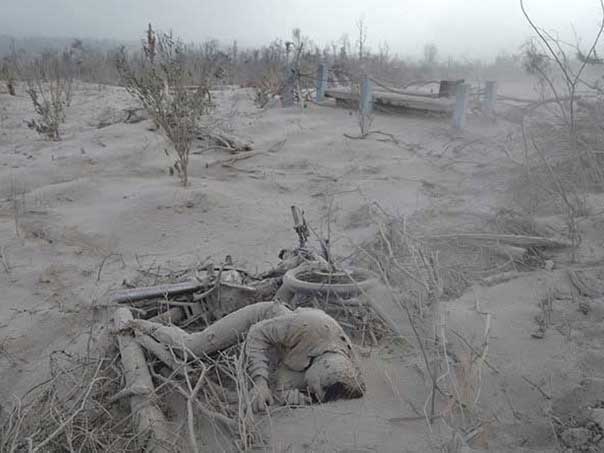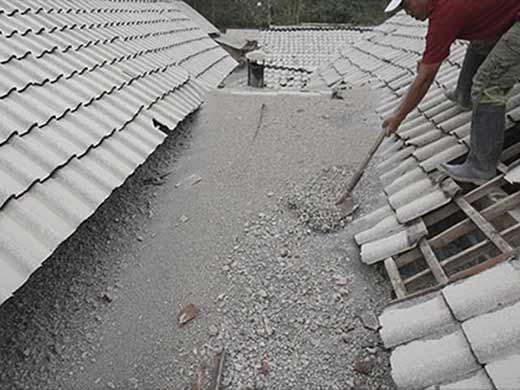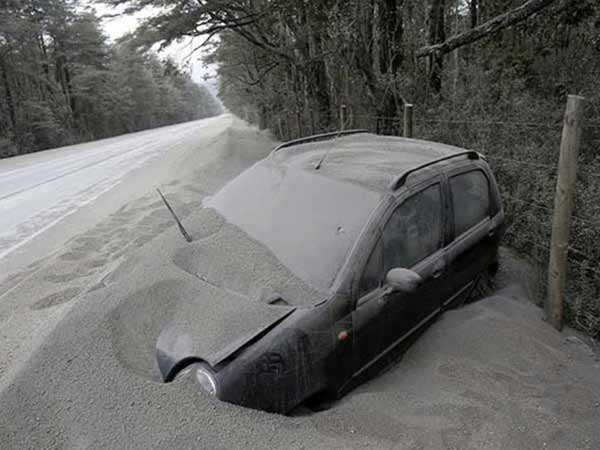Dangers From Volcanic Ash
 Volcanic ash can be deadly
Volcanic ash can be deadlyUnderstanding and avoiding the dangers and problems caused by volcanic ash.
Volcanic eruptions can deposit large amounts of volcanic ash, a very abrasive sand or dust like material that can be damaging to our health and can cause all sorts of problems in our homes, our water and electrical supplies, the mechanical and electrical equipment we use, our vehicles and motor cycles, the aircraft we fly on and the supporting infrastructure that surrounds us. Here we will look at volcanic ash, what it is, how it is formed, the many threats and risks it poses for us and precautions we can take to protect ourselves.
To read more about dangers from volcanoes see:
Volcanic Ash
Apart from tourism volcanic ash affects far more people than any other aspect of a volcanic eruption. Let us look at what volcanic ash is, the many ways it can impact our lives and the steps we can take to protect ourselves.
The eruption of Tambora in April 1815 threw enormous amounts of ash high into the atmosphere, held aloft and blown around the world by the jetstream the ash made the skies dark around the world resulting in lowering of earth?s temperatures, extreme weather events, worldwide crop failures and famine. The ash affected millions of people.
What is Volcanic Ash?
Under normal circumstances when a volcano erupts there are a series of ongoing explosions caused by both the rapid production of steam and the rapid release of gas in the magma as it comes to the surface. These explosions shatter the rock and magma into tiny particles, technically volcanic ash refers to particles smaller than 2mm across although in reality people include much larger particle size as volcanic ash.
These are particles of volcanic rock and glass that can be very hard. Large particles are rather like grains of sand while very fine grains are like dust. Being created in explosions they are also usually angular with sharp edges and, as a result, volcanic ash can be very abrasive.
Acid Rain
If rain falls during an eruption the clouds of volcanic ash may be accompanied by acid rain. As rain falls it can absorb gasses making the water droplets acidic.
Distribution of Volcanic Ash
Volcanic ash is often thrown high into the air during an eruption forming a plume of ash cloud above an erupting volcano. Larger particles may fall fairly quickly while smaller ones may be carried away on the wind and may stay in the upper atmosphere for years. The plume may reach as much as 25 kilometres high, the last eruption of Mount Agung was 8 to 10 kilometres high. At these heights we are into the jetstream, the bands of high velocity winds that circle the earth. As we can appreciate volcanic ash can be carried huge distances from the volcano.
Volcanic ash can fall leaving anything from a fine layer of dust like particles to very thick layers of ash which, in extreme cases, can be metres deep. The Roman town of Pompeii was quickly covered in a 4 to 6 metre thick layer of volcanic ash when Mount Vesuvius erupted in AD 79 leaving many people mummified in deep ash and frozen in time. You can see an animation of the destruction of Pompeii here : https://www.youtube.com/embed/dY_3ggKg0Bc
How do we know if we have a problem with volcanic ash?
Thick ash clouds we can see but often the particles are so fine we don?t even notice them. This is a problem for aircraft that can fly into volcanic ash without knowing it is there.
An effective way of knowing if there has a been a fall of volcanic ash is to look at a smooth surface such as the bonnet of a car, a layer of fine dust is often a tell tale sign.
Keep alert to volcano warnings and updates which will tell of ash clouds, watch the wind direction from the volcano to see if it is coming your way. Nearby airports will be well aware of volcanic ash in the area.
Hazards and Dangers from Volcanic Ash
Volcanic ash consists of hard angular particles that can be very fine, it can be very abrasive, corrosive depending on its chemical composition and its exposure to acidic gasses, it is not soluble in water but can be contaminated with poisonous aerosols, it can conduct electricity when wet, it has an amazing ability to get into any opening in buildings, cars or anything else. Being made up of rock it can be heavy if it falls in thick layers.
Health Risks to humans and animals
Inhaling volcanic ash can cause irritation of the respiratory tract and lungs.
Getting it into your eyes can cause redness and burning sensations in the eyes, abrasion of the cornea, inflammation, discharge and conjunctivitis.
If you have sensitive skin it can cause irritation and secondary infections from scratching.
Humans and animals can be at risk from contaminated drinking water and contaminated fruit and vegetables.
Grazing animals can be affected by eating ash covered grass and fodder.
Ash fall can lead to water and crop shortages resulting in dehydration and starvation in severe cases.
Ingested ash can result in gastrointestinal issues and fluorosis.
Volcanic as can be abrasive on the feet and hooves of animals.
Precautions:
- Avoid going out if ash is in the air.
- Wear a facemask and wear goggles if you have sensitive eyes and, if you have sensitive skin keep the skin covered particularly when riding a motor cycle.
- If you get ash in your eyes use an eyebath with lots of water to gently remove the ash. If this doesn't work or your eyes seem to be damaged go and see an eye specialist.
- Protect your water supply from contamination. change pets and animal drinking water regularly.
- Wash fruit and vegetables thoroughly. Hose down grass or fodder for livestock to wash the ash off.
Buildings
Volcanic ash can easily penetrate buildings being a health hazard for occupants and leading to damage to electrical equipment, paintwork, fittings, furnishings and floors. It is best to prevent ash entering buildings as much as possible.
Roofs

A thick layer of ash can be very heavy, the weight may overload roof structures and may lead to the collapse of buildings. If it rains and the ash becomes wet it becomes much heavier.
Walking on roofs covered by a layer of ash can be dangerous, if there is a thick layer of ash roofs, including flat roofs, might collapse. Walking on a sloping roof covered in loose ash can be hazardous especially if it is wet and the ash becomes slippery.
Air can pass easily through roof tiles and so extensive deposits of ash may be left in roof spaces above ceilings.
Aluminium insulation foil under roof tiles can considerably reduce the entry of ash.
Zinc alume roofs or roofs of corrugated sheets tend to seal quite closely and may keep ash the out.
Metal roof sheeting, fasteners and cladding may be vulnerable to corrosion from the ash.
Alang alang (thatch) and shingle roofs will tend to keep ash out though a lot of work will be needed to clean out the ash later.
Particular attention should be paid to where roofs meets walls, many buildings tend to have gaps between roof beams where they lie on the top of walls.
Gutters, Downpipes and Drains
Roof gutters, downpipes and drains may clog with volcanic ash particularly in heavy ashfall and during the cleanup afterwards. Remember the ash can be heavy and gutters are very often installed without due consideration for the weight of water they carry so, when filled with ash, they may well collapse. Gutters should have substantial brackets mounted every 60 cms along the edge of the roof.
Ash can block drains so it is a good idea to block the entry points to drains.
Water Supply
Ash can contaminate water supplies and can damage pumps. It is a good idea to prevent ash getting into your water supply, cover water tanks.
Paintwork
Volcanic ash can damage paintwork particularly newly applied paint.
Floors
Ash is abrasive and can damage floors.
Precautions for buildings:
- Try and seal buildings to keep the ash out. Anyone who has lived near a beach knows that this is not easy. Pay particular attention to doors, windows, exhaust fans and access manholes to roof spaces. Also look for holes where air conditioner pipes pass through walls.
- Designate one door to be used for access to the building, it is particularly useful if you have two doors you have to pass through to act as an air lock.
- Allocate a room near the entrance ( a laundry may be very suitable) as a decontamination room where you can remove ash covered clothing and shoes when entering the building.
- Seal doors between rooms so that if ash penetrates one area of a building it cannot travel to other rooms.
- Cover ventilation vents above windows and doors or in walls both on internal and external walls.
- Cover tiled roofs with plastic sheets to reduce the entry of ash between the roof tiles.
- Clean ash away from time to time to avoid excessive build up.
- Make sure you have supplies of anything you might need such as plastic bags and wrapping, duct tape, vacuum cleaner, water hoses.
Electric Motors and Controls
Moving parts are vulnerable to abrasion and electric motors are particularly at risk. Ash can get into motors and may damage thrust bearings and their seals, commutators, brushes and bushings. In addition to the risk of damage to the motor itself damaged electric motors can easily overheat and set on fire.
In many households electric motors are used in water pumps, pool pumps, well pumps, air conditioners (both the internal and the external units), ceiling fans, exhaust fans, wall and free standing fans, washing machines, tumble driers, electric and gas ovens, refrigerators, freezers, dish washing machines, rotisseries, microwave ovens, hairdryers, electric shavers, electric toothbrushes, computer cooling fans.
Ash can also clog and damage electrical switches, solenoids and actuators which are used in electronically controlled electrical equipment such as automatic pump switches, timers, float sensors in water tanks and program control in washing machines.
Precautions for electric motors and controls:
- You can wrap electric motors and /or equipment in plastic bags to keep the ash out but it is important to remember that the plastic bag will prevent air circulation to keep the motor cool, so the motor will get hot and could burn out or even start a fire. Avoid using equipment with electric motors if possible.
- Remove any ash with a vacuum cleaner, soft brush or compressed air (less than 30psi) before switching equipment on.
Pumps
Pumps are driven by electric motors and, in addition to the vulnerability of the electric motor itself, pumps have bearings and an impeller (a disc with flutes cast into it that does the pumping). Volcanic ash can cause serious erosion to pump impellers and can damage bearings and their protective seals.
Swimming Pools
Swimming pool pumps need special mention, The water in a swimming pool can collect a lot of ash which is then circulated through the pump and filtration system. The ash can damage the pump and clog the filtration system. If the filtration system or pipework becomes blocked the pump may become overloaded and burn out.
The standard filtration used in swimming pools is designed to collect particles from the water, it will not remove any chemical contaminants or acidity from the water.
Precautions for pumps and pools:
- Prevent ash from getting into water that is being pumped.
- Cover your swimming pool with plastic sheeting to keep the ash out. Remember that rain will carry ash with it and may become acidified.
- Only run the circulation system a minimal amount each day, just sufficient to prevent the pool going green.
Air conditioning and ventilation equipment
Air conditioning and ventilation equipment is particularly vulnerable to damage from volcanic ash. Both the indoor and outdoor units pf air conditioners have electric motors driving the compressor and air circulation fans. The ash can damage both the motors and the fan bearings. The ash can also damage other moving parts such as the oscillating direction fins on indoor units.
Don?t rely on the filters on air conditioners, they were never designed to cope with a heavy amount of volcanic ash. If they get too clogged this can overload to fan motors leading to overheating and failure. Also, as with the beach sand experience, trying to prevent ash getting in even with filter screens fitted is a very difficult thing.
Precautions:
- Try and avoid using air conditioners if you can, if you need air circulation to keep cool try and make do with fans, they are far cheaper to repair or replace.
- Wrap air conditioners units in plastic with strong to tape to seal them up.
- Do not expect the filter screens to protect the units.
- Remove ash from metal surfaces to prevent corrosion.
Vehicles, Motor Cycles and Generators

Fine volcanic ash can be destructive to anything with moving parts. It has the amazing ability to penetrate any opening and cause serious damage inside combustion engines, gearboxes and differentials. The abrasive particles can penetrate and damage seals the get into bearings and gear drive chains.
Ash can block air filter elements which have not been designed to cope with dealing with ash clouds, blocked filters can result in overheating of engines.
Heavy ash can clog radiators leading to overheating ad engine damage.
Ash can penetrate hydraulic systems and can cause serious damage to hydraulic pistons such as those used in vehicle braking systems.
Brake assemblies can become clogged with ash and may stop them working correctly.
Many electrical motors are used in cars these days including starter motors, windscreen wipers, radiator cooling fans, alternators, window winders, fans and air conditioning units. These are all vulnerable to the risks we have listed above under electric motors.
Ash caught under windscreen wiper blades can scratch windscreens.
Ash can cause corrosion and abrasive damage painted metal surfaces such as car bodies.
- Store vehicles in closed in garages, cover them to keep the ash out.
- Remember that vehicles driving through ash can stir it up and suck it into all the nooks and crannies of the vehicle.
- Unless absolutely necessary avoid driving vehicles in dense ash conditions either ash in the air or ash that has fallen on the road. Drive at low speeds.
- Do not drive too close behind other vehicles that may be throwing up ash from the road.
- Service vehicles regularly and make sure brake systems are fully cleaned out.
- If you suspect ash penetration change the engine, gearbox and differential oils making sure the old oil is flushed out to get rid of the ash.
- Keep the radiator and air cleaner elements free of ash. You can clean an air cleaner element by blowing the ash out using compressed air, always blow the air from the inside to the outside of the filter element.
- Use compressed air to drive ash out of electrical motors and components, be careful around bearing seals, strong jets of air can drive ash under oil seals.
- Remove ash regularly as it can corrode metal surfaces. Do not wipe ash off the body of vehicles using a cloth or sponge, the particles can scratch the paintwork. A light sprinkling of ash can be removed using a fine brush or feather duster, heavier layers of ash can be washed off with a hose pipe using copious amounts of water. Do not use a strong jet of water, this can drive particles under the seals of bearings and other seals such as door surrounds.
Computers
Computers can be damaged by volcanic ash. The ash can get into moving parts and jam them up. Cooling fans, keyboards, mice, touchpads and CD drives are vulnerable.
- Wrap computers in plastic sealed with tape.
- If ash gets in clean it out with compressed air.
Aircraft
Volcanic Ash can be devastating for aircraft, the hard abrasive particles can sand blast cockpit windscreens, the leading edges of wings and other surfaces, antennas and sensors and navigation and (depending on where they are mounted) landing lights. Ash can seriously damage engines and can even stop them if the ash cloud is very thick. One night the Boeing 747 of British Airways flight 9 flew through a cloud of volcanic ash over Indonesia?s Mount Galunggung in 1982, the ash was so dense that it stopped all four engines, the plane fell 24,000 feet and only a superhuman effort on behalf of the crew managed to get the engines started again at the last minute. It wasn?t until they came into land that they found that they couldn?t see through the windscreen and their landing lights were damaged, they managed to land peering through a very narrow undamaged strip along the bottom edge of the windscreen.
You will notice that aircraft don?t fly anywhere near clouds of volcanic ash.
To read more about dangers from volcanoes see:
Phil Wilson
Copyright © Phil Wilson
This article, or any part of it, cannot be copied or reproduced without permission from the copyright owner.
